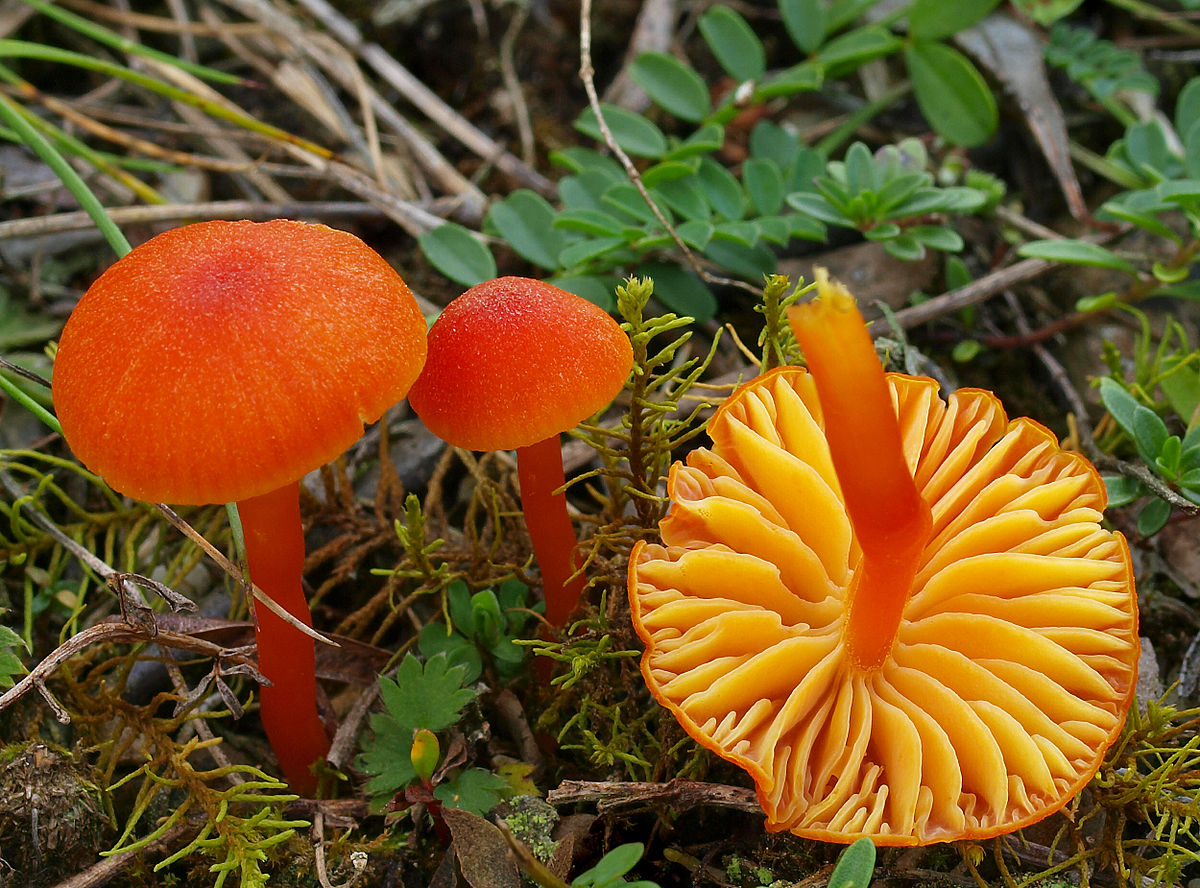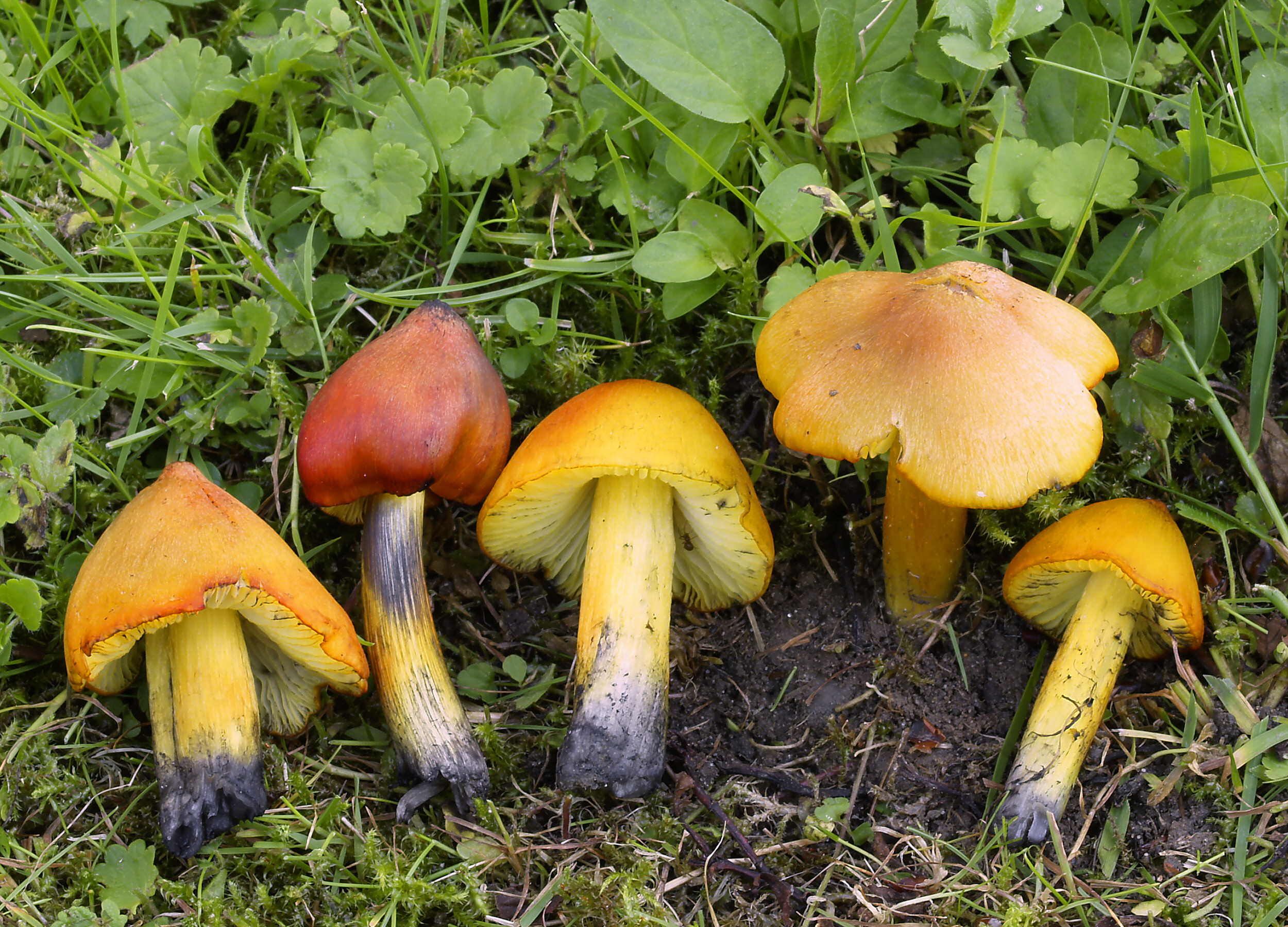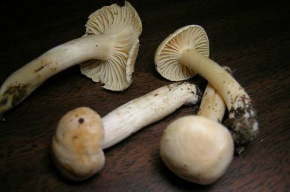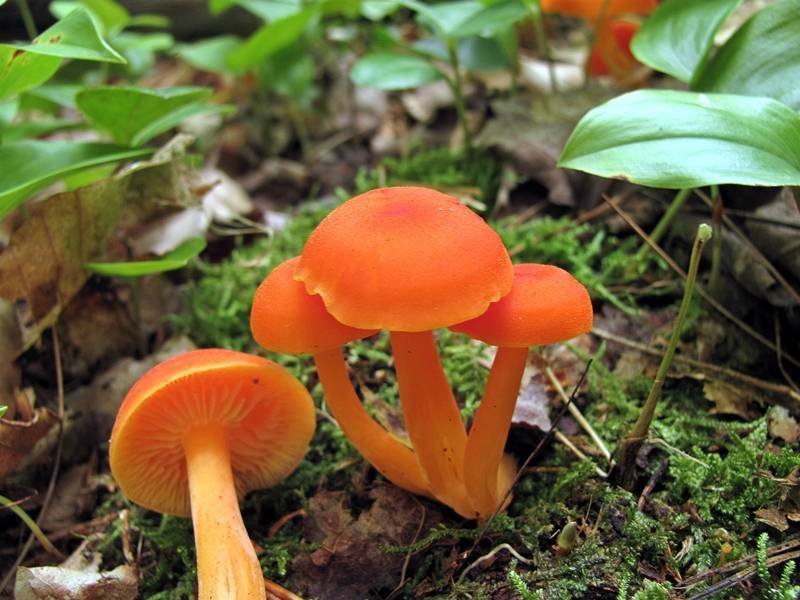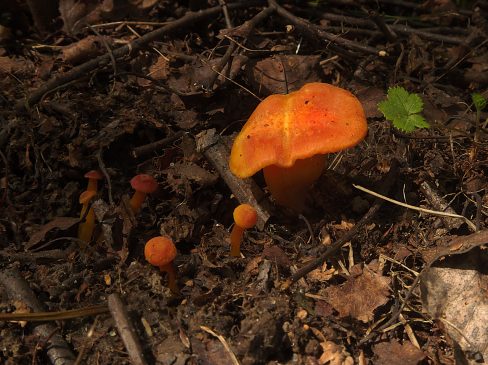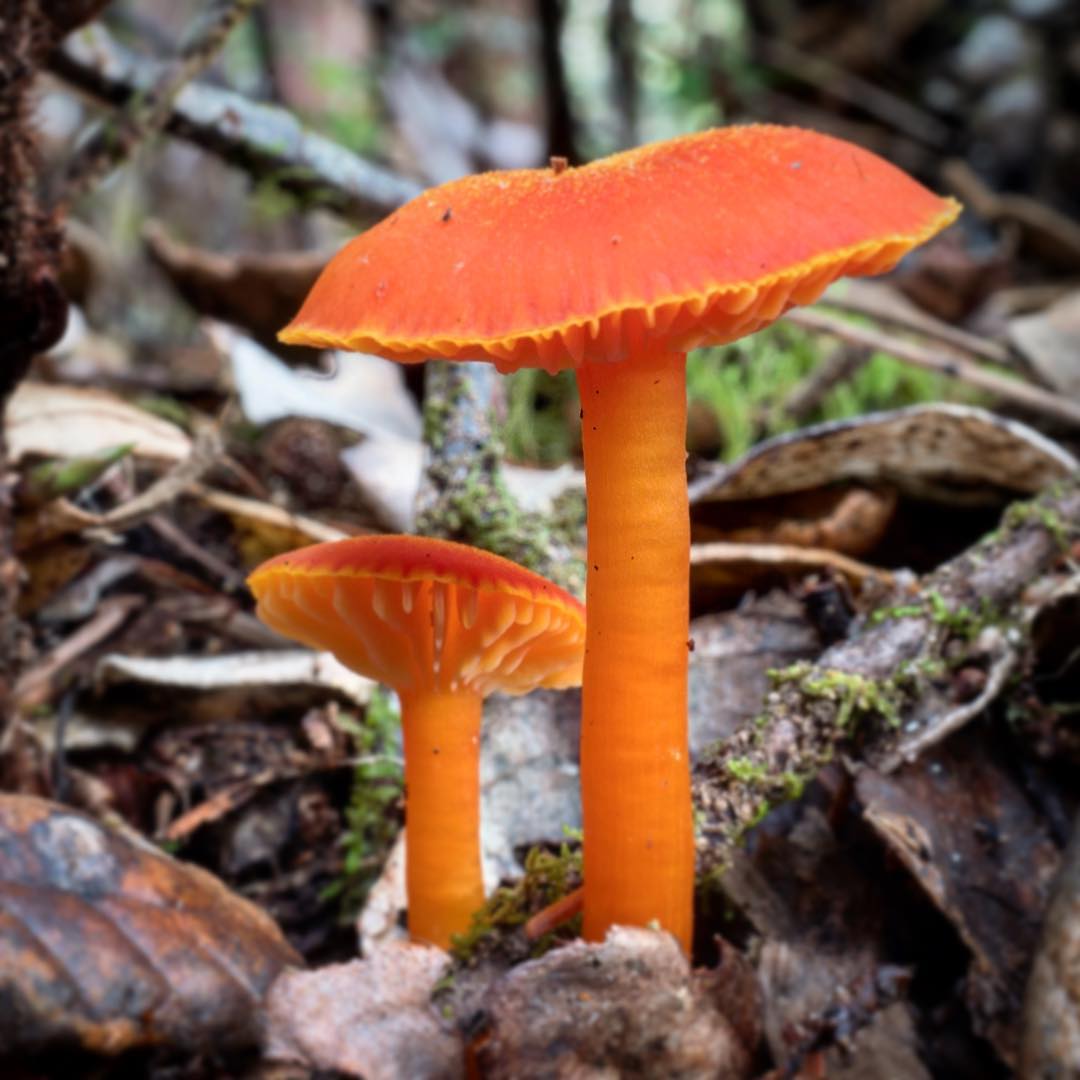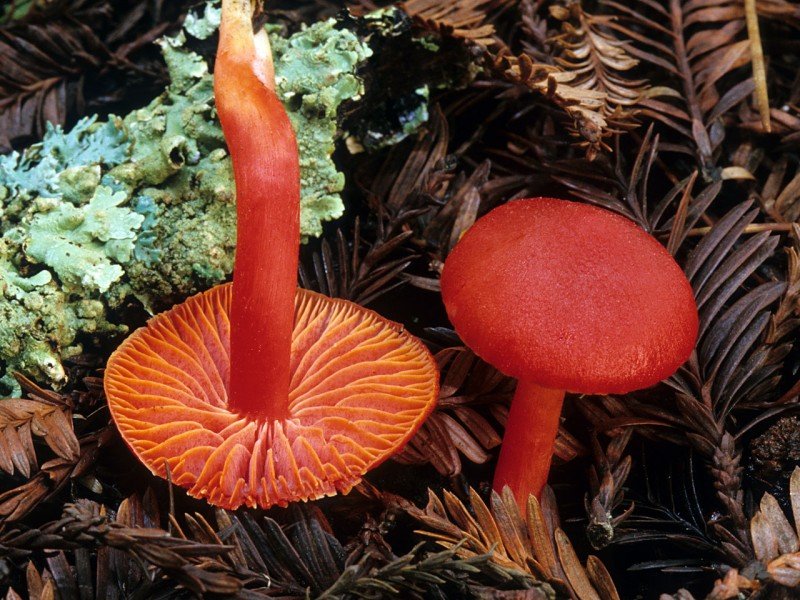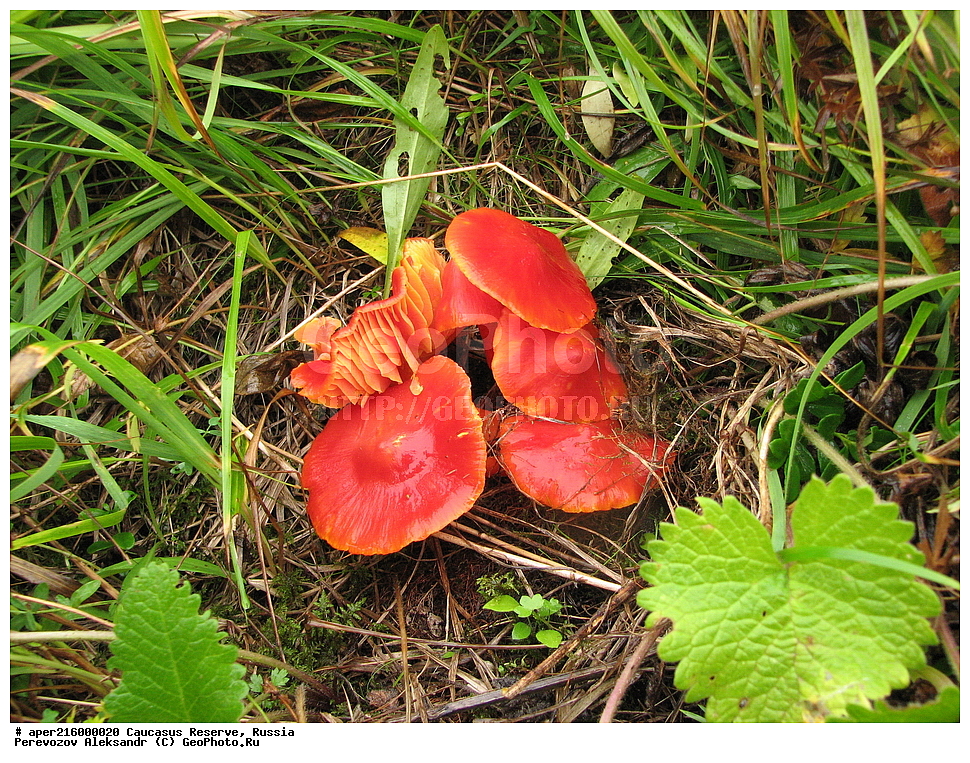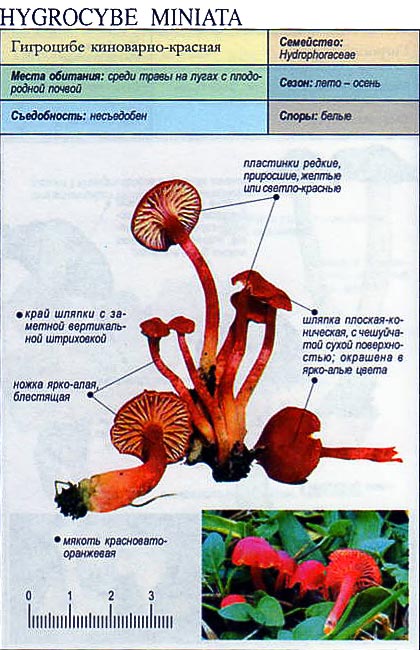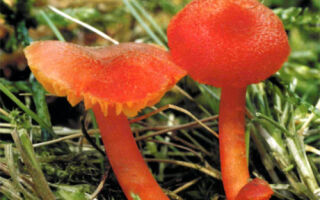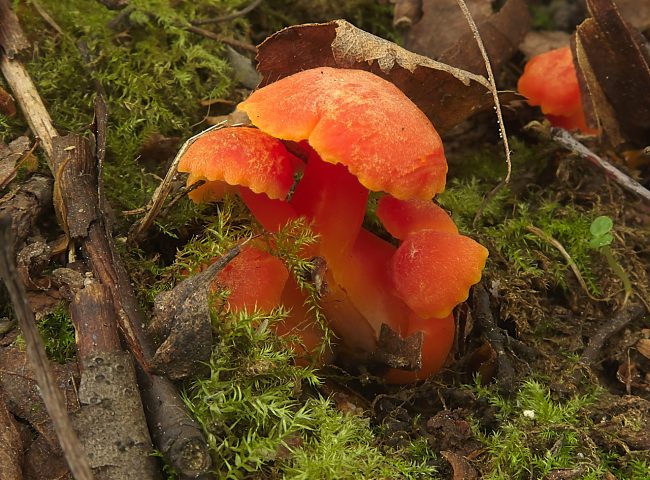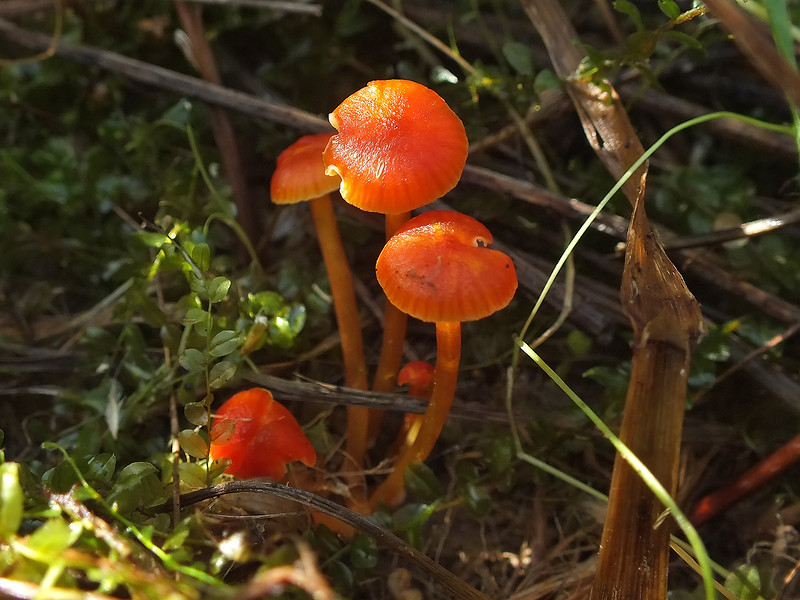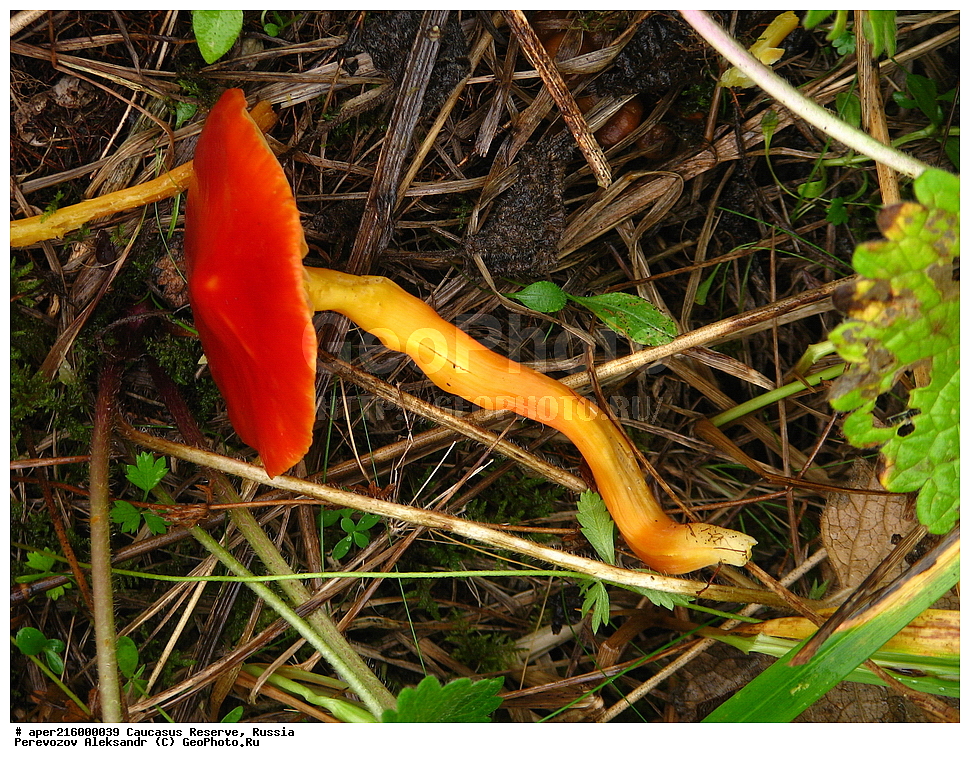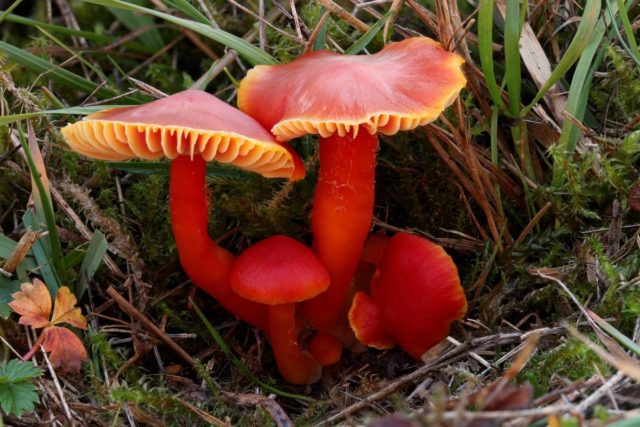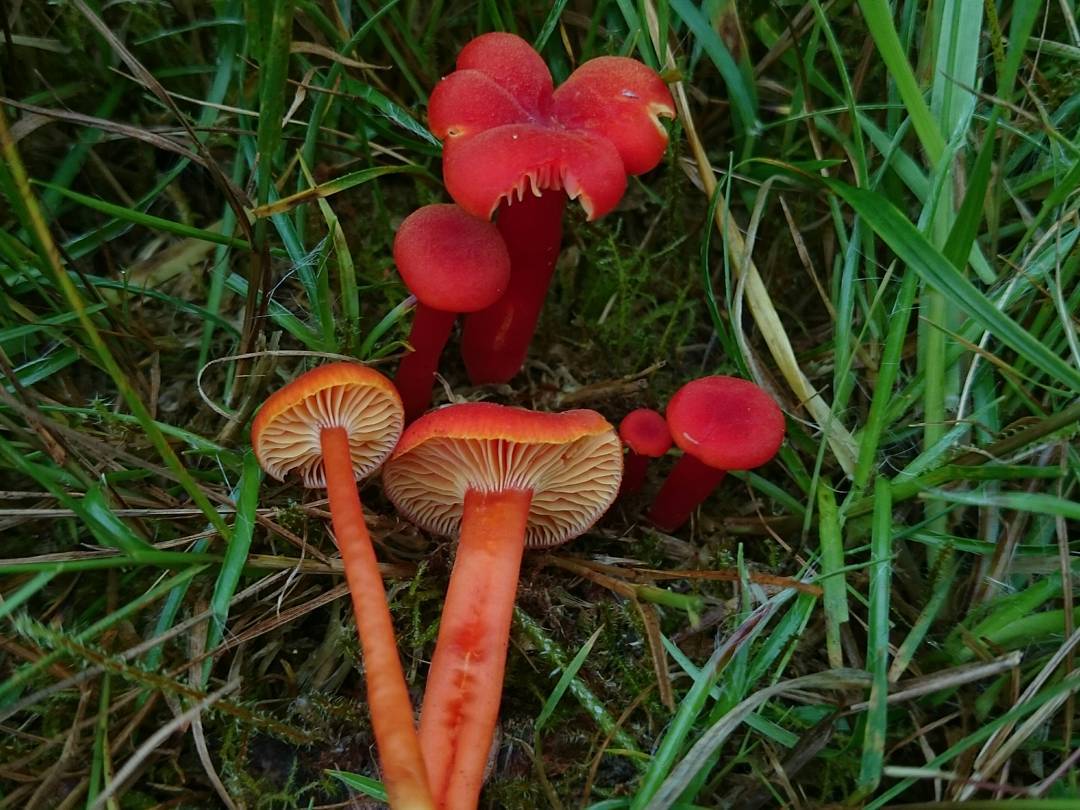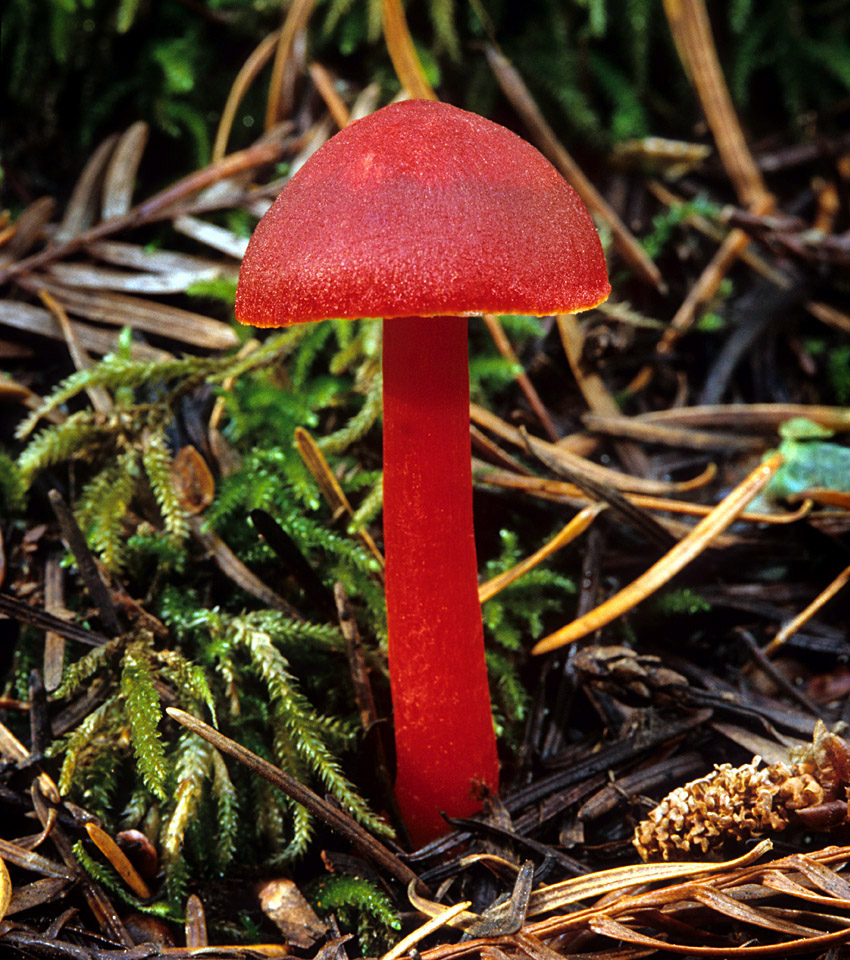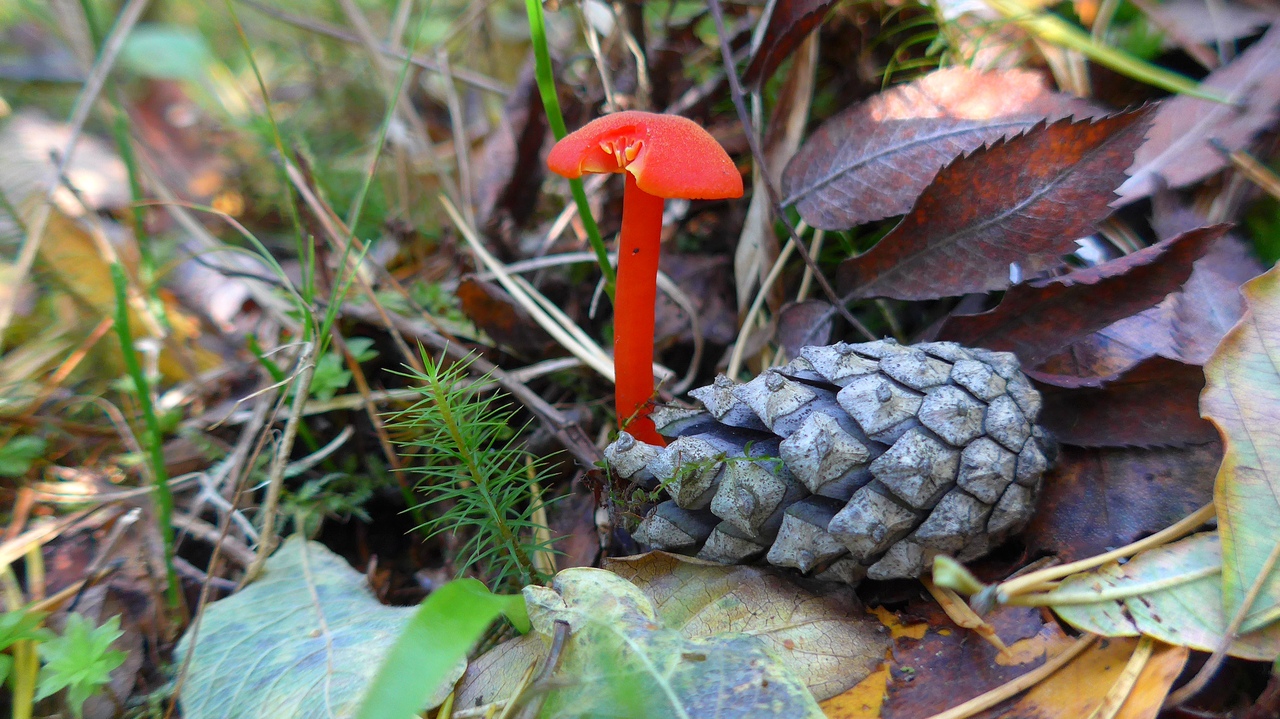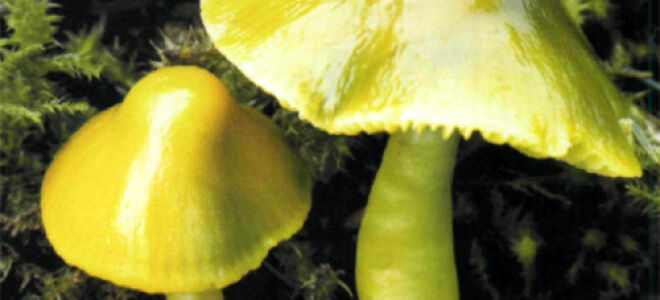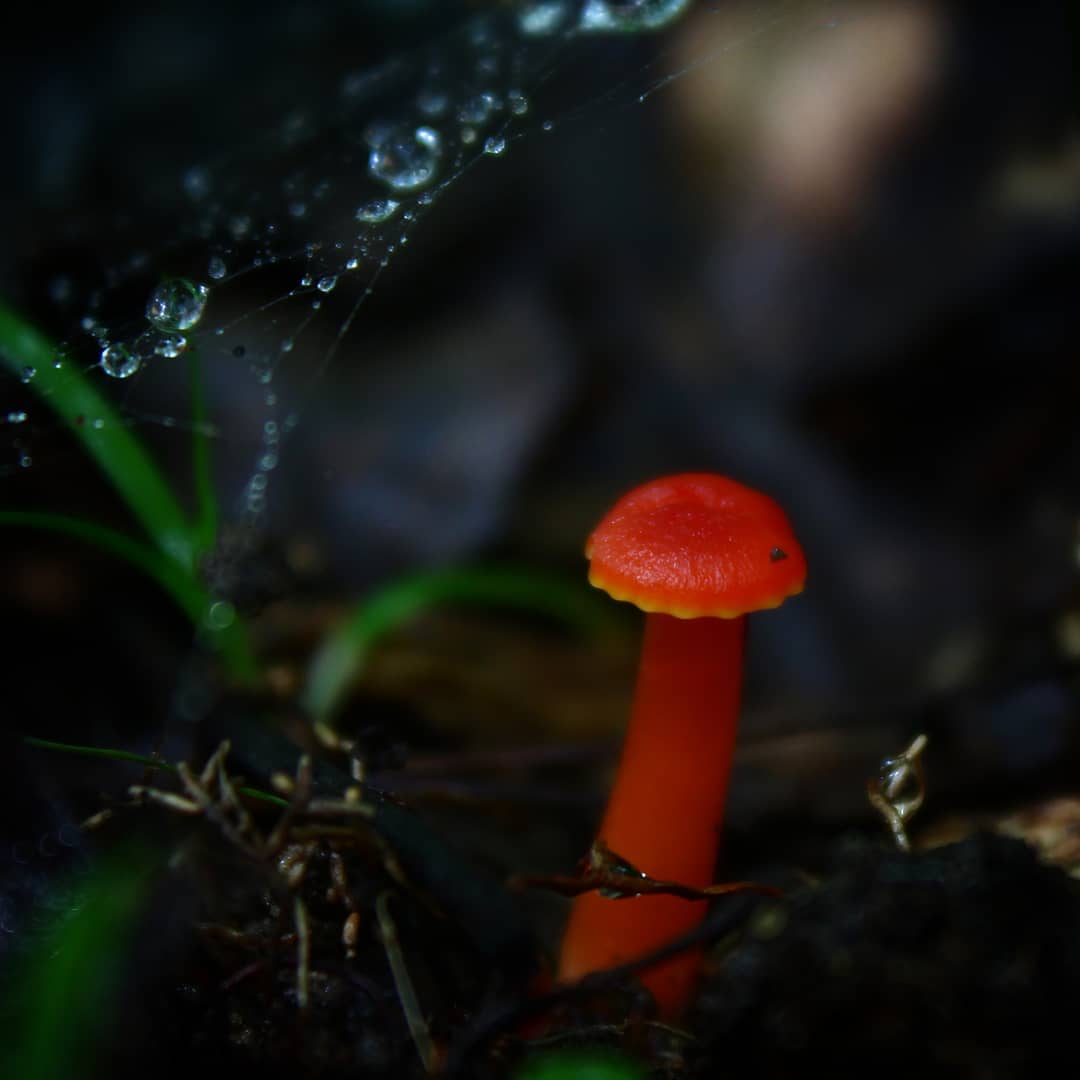Description of hygrocybe crimson
The fruit body of a crimson hygrocybe consists of a cap and a leg. The cap has a conical or bell-shaped shape, but this applies only to young specimens; at a later age, the caps become flat. All specimens have a small tubercle in the center.

The surface of the hygrocybe is crimson smooth, covered with a thin sticky layer. In some fruiting bodies, grooves are visible on the caps. The diameter of the cap can be up to 12 centimeters.
The leg is hollow, thick, grooves may be present along its entire length. The shade of the leg matches the cap or may be slightly lighter. There are wide plates under the head. The structure of the plates is fleshy. They do not attach well to the leg. The color of the plates in young mushrooms is ocher, and over time they turn red. The flesh of the crimson hygrocybe is very dense, it has a specific unpleasant smell.
Description of the conical hygrocybe
The diameter of the cap is 2-9 centimeters. Young mushrooms are characterized by a cone-shaped pointed cap, and in adulthood, the shape of the cap becomes wide-conical, while a tubercle remains in the middle. The cap most often breaks at the edges. The surface of the cap is fine-fibred, very smooth. In rainy weather, the hat becomes shiny, slightly sticky, and in dry weather, the hat is silky and shiny.
The color of the cap is red-yellow or orange-red, while the tubercle is always much brighter. In old age, mushrooms become darker. If you press on the cap, it also becomes darker.
The leg is even and almost straight, only in the lower part there is a slight thickening. Inside, the leg is hollow, the structure is fine-fiber. The color of the stem is yellow or orange, and whitish at the base. The leg is not covered with mucus.
The conical hygrocybe plates can be located freely or, on the contrary, can be tightly attached to the cap. The edges of the plates widen slightly. The color of the plates is yellowish, but becomes grayish with age. When pressed on the plates, they turn grayish-yellow. The pulp is thin and fragile. The color of the pulp matches the color of the leg. When pressed on the pulp, it turns black. The taste and smell of the pulp are not expressed. Spore white powder. The spores are ellipsoidal, smooth and colorless. Buckled hyphae.
Places of growth of a conical hygrocybe
These mushrooms are found mostly in rare young plantings. Most often they can be found along the roads and in the moorlands. In addition, the conical hygrocybe grows in grassy places: in pastures, glades, meadows. In forests, these mushrooms are much less common. These mushrooms begin to bear fruit in May and continue until October.
The toxicity of the conical hygrocybe
The conical hygrocybe is considered a weakly poisonous mushroom. It is not recommended to eat this type of mushrooms, as these mushrooms can cause eating disorders.
Distinctive features of a cap-shaped hygrocybe
The diameter of the cap varies from 2 to 6 centimeters. A young mushroom has a pointed-shaped cap, in fact, thanks to this, the name came about. Over time, the shape of the cap becomes more sloping, and in mature mushrooms it spreads completely.
At first, the color of the mushroom is quite bright: coral-red, terracotta, wine-brown, orange, and at the end of the season the mushroom fades and becomes light pink. The central part of the cap is much lighter, even whitish. The surface can be sticky or dry. The edges are clearly serrated.
The pulp is pink, thin, and quickly falls apart in the hands. The plates are attached to the stem with the help of teeth. Their colors are mostly light, pale pink. They can be located frequently or infrequently.
The stem of this family of mushrooms can be quite long and reach 16 centimeters. But often there are cap-shaped hygrocybes with short legs that do not exceed 2 centimeters.The leg has a small thickness - only 1 centimeter, so it is very fragile. The surface of the leg is completely smooth, without roughness. The leg is firmly fixed in the substrate. Its shape can be ovoid or elliptical. The spore sac is white or light cream.
Spreading cap-shaped hygrocybe
These mushrooms originally became known in Europe, North America and Japan. Most often, cap-shaped hygrocybe grow in groups, and separately growing specimens are rare.
These mushrooms grow in humus and soil, they prefer rich soil. They can be found in mixed and coniferous forests. Cap-shaped hygrocybe is a moderately common type of mushroom.
Edible hygrocybe cap-shaped
The cap-shaped hygrocybe is considered an edible species, but mushroom pickers collect it quite rarely, since it does not differ in special taste, there is also no smell.
Related species
- Hygrocybe scarlet, she is also hygrocybe red, has a variable color from bright scarlet to pale orange. These mushrooms grow in meadows, meeting from late summer to late autumn. Scarlet hygrocybe is not popular as an edible species, but it is a non-poisonous mushroom;
- Hygrocybe wax is a bright orange mushroom. They grow singly or in small groups. The distribution area covers Europe and North America. The wax hygrocybe is inedible, but, most likely, non-toxic, since no cases of poisoning have been recorded;
- Oak hygrocybe has a yellow-orange color. The growing places of these mushrooms are deciduous and mixed forests, most often they are found near oak trees. The mushroom is not poisonous, but has no nutritional value;
- Hygrocybe cinnabar red is distinguished by cinnabar red color. It grows in mossy and grassy places, in glades, meadows and wetlands. Occurs from July to August. The opinions of mushroom pickers differ on the nutritional qualities of this mushroom, some claim that it is an inedible mushroom, and others that they can be eaten, but they have no practical significance;
- The conical hygrocybe is characterized by a yellowish, orange and in some places reddish color. These mushrooms grow mainly in young rare plantings and along roads, and in forests they are more rare. They bear fruit from May to October. The conical hygrocybe is not suitable for eating, as it can provoke an upset stomach. It is considered a slightly poisonous mushroom;
- The beautiful hygrocybe has a very varied color: light wine-gray, lilac-gray, olive, red-red and red-orange, sometimes it can be pinkish and greenish. These mushrooms are widespread in South America, North America, Europe and Japan. They grow in groups on humus, meeting in coniferous and mixed forests;
- Crimson hygrocybe is distinguished by its crimson or red color. Turning into orange. These fungi are ubiquitous in humid, open areas. It is a good-tasting edible mushroom that can be fried and canned;
- Hygrocybe turunda is a bright red inedible mushroom found in summer and autumn;
- Hygrocybe acutely conical is characterized by a yellow-orange or yellow color. Grows in meadows and pastures of various types. Fruiting time is in summer and autumn. These are inedible mushrooms, as they contain toxic substances.
Hygrocybe acute conical: description and photo
| Name: | Hygrocybe acute conical |
| Latin name: | Hygrocybe acutoconica |
| Type of: | Inedible |
| Synonyms: | Hygrocybe persistens |
| Specifications: |
|
| Systematics: |
|
The conical hygrocybe is a member of the widespread genus Hygrocybe. The definition arose from the sticky skin of the top of the fruiting body, soaked in liquid.In the scientific literature, the mushroom is called: hygrocybe persistent, Hygrocybe persistens, Hygrocybe acutoconica, Hygrocybe conica.
There is another option for domestic use: a wet head.

A distinctive feature of the inedible variety is the pointed tip of the bright mushroom body
What does a hygrocybe look like?
The cap has a tapered cone shape, which is especially characteristic of young mushrooms. As the edges grow, they move away, the silhouette of the apex becomes wide-conical. The tubercle in the middle remains, the fragile border often breaks. Thin-fibred, smooth skin becomes slippery, sticky after rain. In the dry period, it seems shiny, silky. The width of the upper part is up to 9 cm, so the mushroom is noticeable both in size and in bright color:
- the entire surface area is yellow-orange or yellowish;
- the elevation in the center is much more intense in color.
At the end of growth, the entire surface becomes darker. When pressed on the fruit body, the skin also darkens.
Light yellow plates of the type are loose or, conversely, are tightly attached to the cap. Their edges are widened. Often the plates do not reach the rim. In old mushrooms, the plates are grayish; when pressed, a dark gray color also appears.
Thin yellowish pulp is fragile, because of this, the edge is often torn, after pressure it turns black. Spore powder is white.
High, up to 10-12 cm, the stem is very thin, only 9-10 mm. Smooth, straight, slightly thickened at the base, fine-fibered, hollow inside. The color of the surface corresponds to the shade of the top, at the bottom it lightens to white.

Fruit bodies of a wet head with toxic substances are distinguished by long thin legs, which distinguish them from similar species
Where does the hygrocybe grow acutely
The species is common in Eurasia and North America in the temperate zone, especially in warm regions. More often, brightly colored mushroom families are found in wet meadows, in old gardens, less often in glades and edges of mixed forests from late spring to the first frost. Hygrocybe sharp-conical prefers alkaline sandy soil, grows under solitary deciduous trees.
Fruit bodies are similar to other wet heads with a brightly colored surface, especially a slightly poisonous conical hygrocybe, the surface of which darkens after pressing.

The fruiting body of a similar mushroom turns black after ripening.
Is it possible to eat a hygrocybe acutely conical
Toxic substances have been identified in the pulp of yellowish-orange moist heads with a pointed tip. The conical hygrocybe is inedible. No pronounced odor emanates from the pulp. Poisons of the sharp-conical type are not fatal, but can cause serious illness. An orange-yellow cone-shaped hat with a pointed tubercle in the center should serve as a warning to inexperienced mushroom pickers.
Conclusion
The conical hygrocybe is a representative of a widespread genus, which includes small mushroom bodies, conditionally edible and inedible, some of which are poisonous. The brightly colored pointed tip signals that the mushroom should not be picked.
Views
Main article: Species of the genus Hygrocybe
The genus has about 140 species with varieties, some of which are poisonous. There are about 130 species in Russia.
| Cat. * | Latin name | Russian name | ||||||||||
|---|---|---|---|---|---|---|---|---|---|---|---|---|
| Hygrocybe calciphila | Calcium-loving hygrocybe | |||||||||||
| Hygrocybe calyptaeformis(H. calyptriformis) | Hygrocybe cap-shaped | |||||||||||
| Hygrocybe cantharellus | Chanterelle hygrocybe | |||||||||||
| Hygrocybe ceracea | Hygrocybe wax | |||||||||||
| Hygrocybe chlorophana | Hygrocybe yellow-green, hygrocybe dark green | |||||||||||
| Hygrocybe citrinovirens | Hygrocybe lemon green | |||||||||||
| Hygrocybe coccinea | Hygrocybe red, hygrocybe scarlet | |||||||||||
| Hygrocybe conica | Conical hygrocybe | |||||||||||
| Hygrocybe flavescens | Hygrocybe yellowing | |||||||||||
| Hygrocybe flavipes | Hygrocybe gray | |||||||||||
| Hygrocybe intermedia | Hygrocybe intermediate | |||||||||||
| Hygrocybe irrigata | Hygrocybe watery | |||||||||||
| Hygrocybe laeta | The hygrocybe is beautiful, the hygrocybe is bright | |||||||||||
| Hygrocybe marchii | Hygrocybe March | |||||||||||
| Hygrocybe miniata | Hygrocybe cinnabar red | |||||||||||
| Hygrocybe mucronella | Spicy hygrocybe | |||||||||||
| Hygrocybe nigrescens | Blackening hygrocybe | |||||||||||
| Hygrocybe ovina | Sheep hygrocybe | |||||||||||
| Hygrocybe persistens | Hygrocybe acute conical | |||||||||||
| Hygrocybe pratensis | Meadow hygrocybe | |||||||||||
| Hygrocybe psittacina | Parrot hygrocybe, pistachio hygrocybe, motley hygrocybe | |||||||||||
| Hygrocybe punicea | Hygrocybe crimson | |||||||||||
| Hygrocybe quieta | Hygrocybe oak | |||||||||||
| Hygrocybe reidii | Hygrocybe Redi | |||||||||||
| Hygrocybe russocoriacea | Red-skinned hygrocybe, yuft hygrocybe | |||||||||||
| Hygrocybe spadicea | Hygrocybe brown-red | |||||||||||
| Hygrocybe splendidissima | The hygrocybe is brilliant, the hygrocybe is the finest | |||||||||||
| Hygrocybe strangulata | Hygrocybe suffocating | |||||||||||
| Hygrocybe turunda | Hygrocybe lint | |||||||||||
| Hygrocybe unguinosa | Hygrocybe smeared | |||||||||||
| Hygrocybe virginea | Snow-white hygrocybe, maiden hygrocybe | |||||||||||
| Hygrocybe vitellina | Hygrocybe egg yellow | |||||||||||
|

